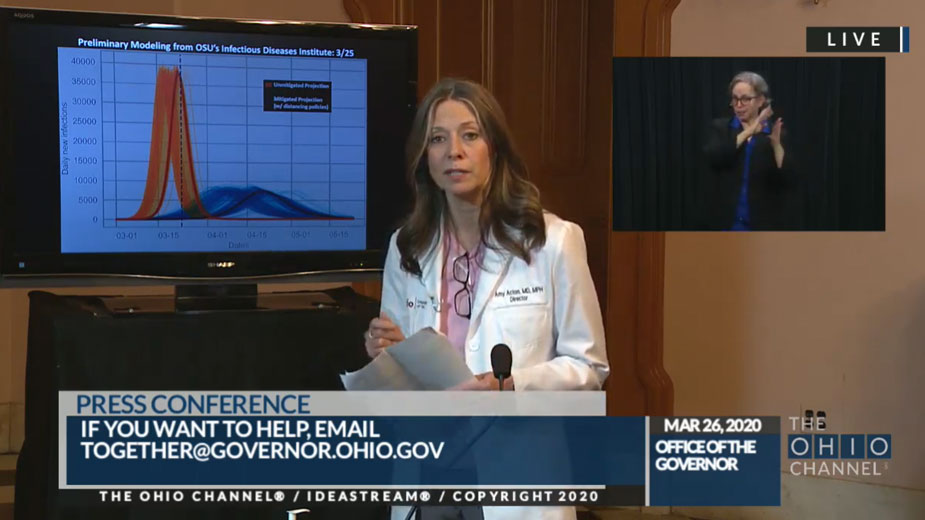Acton: At Peak, Could See up to 8K New Cases Daily
YOUNGSTOWN, Ohio — New preliminary modeling from the Ohio Department of Health shows that the safety measures taken so far are stemming the impact of the surge of COVID-19 cases that are still to come.
Director Dr. Amy Acton explained some of the new charts Ohioans can view at Coronavirus.ohio.gov. The charts, plotted from preliminary modeling by experts at Ohio State University and Cleveland Clinic, offer a first look at the impact of the efforts.
A chart depicting the expected daily rate of new cases compares two curves; orange shows the rate if no measures had been taken, blue shows the expected rate with measures taken so far. The orange curve peaked earlier, topping out at about 40,000 new cases daily.
“This would have been us by our projections,” Acton said during Thursday’s daily coronavirus press conference in Columbus. “This would have been the peak of our surge had we not taken the decisive actions.”
The blue curve tops out at 6,000 to 8,000 new daily cases. Through the collective actions taken, and Ohioans’ adherence to those actions, Acton estimates it has decreased the impact on the health-care system by 50% to 75%.
“But we’ve got to do it even more because we are buying time,” Acton said. “The further we spread out that spread of infection, the more time our hospitals are getting ready and doubling their capacity.”
At this point, “it’s not if, but when” the surge comes, she advised. Currently, the surge is expected to peak toward the end of April, but Acton’s goal is to stretch it out to the beginning of May, further reducing the impact to the health-care infrastructure.
“We will exceed our capacity, but we’re really minimizing that amount,” she said. “Ohio, what you’re doing absolutely is saving lives.”
State officials still aren’t sure exactly how much capacity they will require to meet the needs of the pandemic, but “we know it’s going to have to be a lot, lot bigger,” said Gov. DeWine. He spoke with Gov. Larry Hogan of Maryland, who advised him the state had doubled its capacity, including beds and hospital space.
“I suspect we’ll be very close to that,” DeWine said.
The primary concern for reducing that impact is the dwindling supply of personal protective equipment, or PPE. Had the state taken no preventive measures to slow the spread of COVID-19, the disease spread by coronavirus, “we’d already be way exceeding” the amount of PPE needed to keep health-care workers save during the pandemic, Acton said.
Acton says the state needs extra gloves, gowns and surgical masks, but the big wishlist item are N95 respirator masks. Without taking any action, the state would have needed 65-times more than the typical usage, she said.
“We’ve lowered that down to 40 times as much,” she said. “Even with the efforts we’re making, we’re going to need millions more.”
When questioned about public health-care workers who contract COVID-19 while working, Acton said the state has a contingency plan. The state is bringing back retired epidemiologists to help, and is courting individuals working with universities in the state “who have these same talents,” she said.
The state is also developing an amateur epidemiologist workforce of med students and nurses, “who we intend to use when we finally have extensive testing to blanket Ohio,” she added.
“So we’re building up more workforce. The folks that can work from home are working from home,” she said.
Ohioans have contacted the DeWine administration on how to help, including offering donations of PPE. DeWine says residents can contact the administration at [email protected] to offer assistance.
Copyright 2024 The Business Journal, Youngstown, Ohio.



